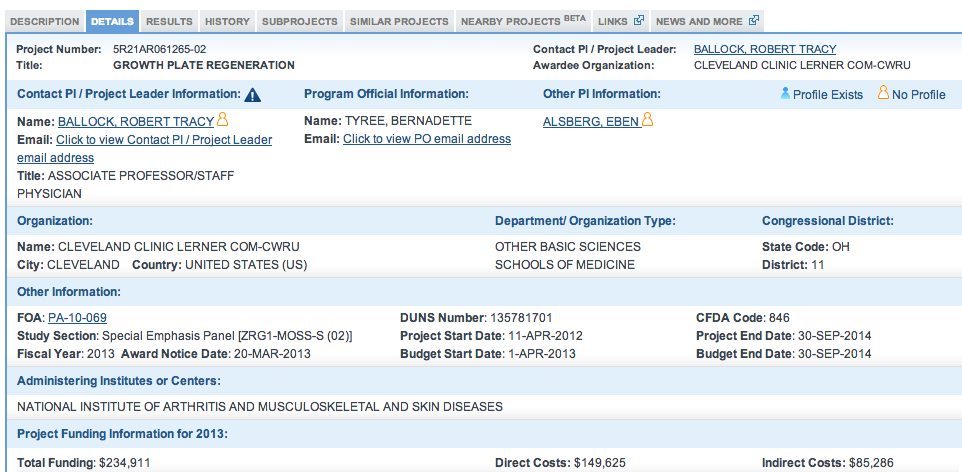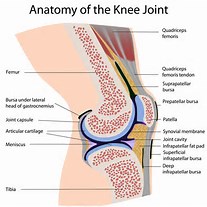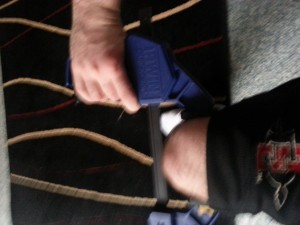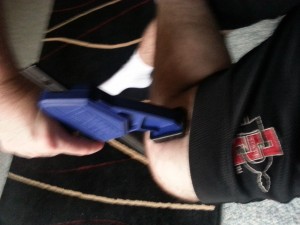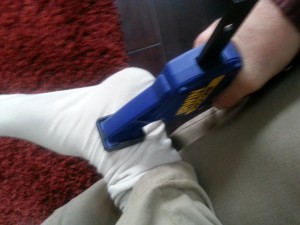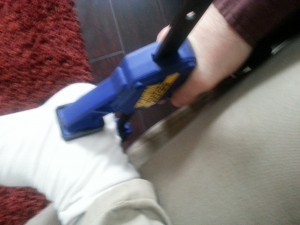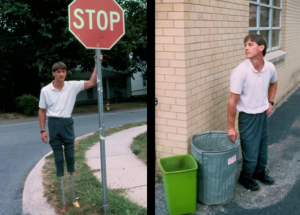Growth Plate Regeneration Update – Robert Ballock and Eben Alsberg Working Together – Getting Very Close!
 I am sure that the regular readers of the website has already seen this grant that I have talked about at least half a dozen times already and linked to but this is the big news I wanted to say.
I am sure that the regular readers of the website has already seen this grant that I have talked about at least half a dozen times already and linked to but this is the big news I wanted to say.
Tyler have said that there are two people who would be very helpful in our quest and they were Cory Xian and Robert Ballock. I fully agree, and I have wrote multiple article on Ballock. This guy was given an award more than a decade ago for being able to fully grow a functional growth plate.
(Source: http://projectreporter.nih.gov/project_info_details.cfm?aid=8458506&icde=21045832)
I also said that people like Dr. Warren Grayson of JHU (with his 3-D Bone grafts) and Jean Welter of Case Western University (with his knowledge on differentiating MSCs into the chondrogenic lineage) would also be critical in pushing the effort forward. The recent news that maybe Alexander Teplyashin’s team based in Moscow might have already put their own created growth plates into human legs to lengthen them showed that some people have already taking it out of just the lab and into human clinical trials.
However, from certain russian sources I found on the russian search engines, it seems that Teplyashin’s team is being legally prevented from moving forward on their goals to get that stem cell tissue engineering technique to be fully researched. The government seems to have implemented certain legislative or legal rules to keep the stem cell research from being implemented to the full capacity.
I am happy to inform the readers that the grant that I had referenced before on Ballock had a key critical bit of information which I did not see in the previous times in looking at them.
It seems that Dr. Robert Tracy Ballock’s partner in the grant is a Dr. Eben Alsberg.
This Alsberg is the same Alsberg which wrote the seminal paper which got me super excited last year, entitled “Engineering Growing Tissue“. Refer to the year old post “Engineering Growing Cartilage Tissue In Vivo Through Chondrocyte Transplantation (Big Breakthrough!)”
Let’s recap some critical facts….
In the grant (Project #: 5R21AR061265-02) , Ballock writes the following…”Successful regeneration of growth plate cartilage architecture in vivo would have a transformational impact on the practice of pediatric orthopaedic surgery, providing for the first time not only the ability to replace growth plates irreversibly damaged by trauma, infection or irradiation, but also the possibility of restoring longitudinal growth in individuals beyond the age of skeletal maturity.”
So Ballock clearly realizes that what he is trying to get to work would have huge implications, and could be used to make people which completely fused growth plates to start to volumetrically grow in bone size again.
If you clicked on the “Details” Tab on of the grant link (Available Here), it is revealed the Alsberg is the other project leader of the project. That means that two of the biggest hopeful professional researchers, both of have successfully grown functional growth plates, have teamed up together to get the technical details and technical hurdles figured out.
Here is probably the most incredible news, which I didn’t share before. The grant was accepted and given money back in April of 2013. The project would be finished by the end of September 2014, which is only two months away the last I checked. So It could be that within 3 months, there will be at least 2 people somewhere in the Western World (not counting the Russians and the Chinese, whose military and government would never reveal their classified research to the rest of the world) who have proven that the regeneration of growth plates is completely viable and would be functional when implanted into humans.
As for anyone who is still hoping that a technology will be created that will “reopen growth plates”, I don’t think that is even theoretically possible, since the basic laws of physics and how matter works would be broken in some ways. I imagine the bone tissue like the tissue of a tree. Once the young, limber tissue of the tree turns old and semi-dead, there is no way to get that tissue back into its younger state. If you want a very specific section of the tree to turn back into its young morphological state, the easiest way is to make a cut into the tree and insert that young piece of tissue. I personally don’t think the technology to “reopen growth plates” will be something that will come about for centuries to come, and the only way for something that crazy to happen is from nano-sized robots which can stimulate each individual cells in the local area to go into transdifferentiation, and at the same time remove the hydroxyapatite calcium crystals and convert the inorganic compounds found in the bone ECM into the organic compounds found in cartilage ECM like collagen type 2 and certain types of proteoglycans.
If you want to find an alternative to limb lengthening surgery in your lifetime, hopefully within the next 30-50 years, this stuff that Ballock and Alsberg is collaborating on is where it is definitely at, which is revolutionary, and I suspect have all the technical kinks figured and worked out already. This is the future of bone remodeling.
Yes, the technique is invasive, and you can’t do that in the privacy of your home, away from prying eyes, judgement by your peers, and embarrassment that you would do something for a cosmetic gain. It would require that a certain part of your bone to be broken, if not sawed in a certain configuration and shape for the cartilage/growth plate implant. That is something which I don’t think we can get around with, at least in the coming century of biotechnology (unless some higher alien civilization is willing to share with us their insane alien medical technology)
However, you would be under the anesthesia. After just maybe 1 week after the growth plates become vascularized and they fuse with the surrounding bone tissue, and the cartilage tissue is tested to be able to handle the weight of the adult person, the surgical patient would be able to go home, and go about their daily lives, with maybe a few injections of MSCs, growth factors, and other chemicals to help modulate the bone growth.
For the perfect analogy, this stem cell & tissue engineering scaffold and graft implant techniques to lengthen bones and make one smaller compared to the older techniques of limb lengthening surgery with metal fixators or internal metal rod which slowly lengthen would be similar to the shift from the older cars using internal combustion engines (wither 4,6,or 8 cylinder) to the new electric, zero-emissions cars like the Tesla Model S (which I got to test drive yesterday). The shift from metal rods which forcefully pull the bones apart to cartilage implants which simulate the natural process of bone volumetric growth is such a shift in paradigm and biotechnological innovation that things will be forever changed, for the good.

